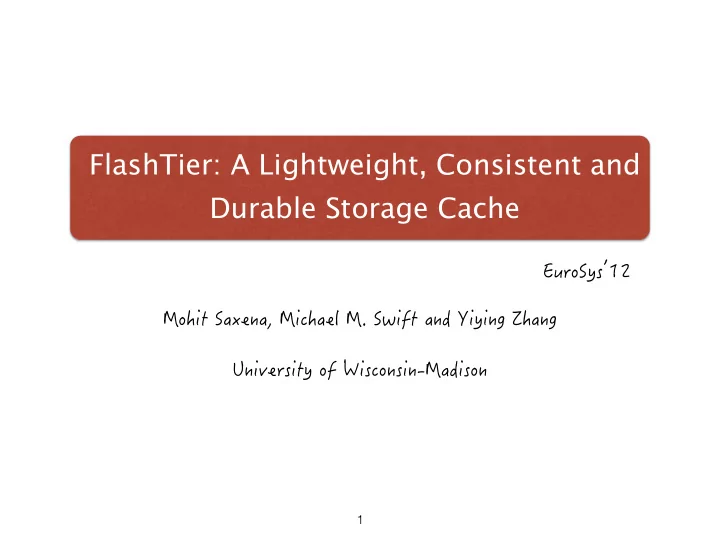

����������������������������������������������� � ������������������������������� � ���������� FlashTier: A Lightweight, Consistent and Durable Storage Cache 1
Outline • Introduction • Motivation • System Design • Evaluation • Related Work • Conclusion 2
Introduction Flash • Flash’s price and performance are between DRAM and disk. • write endurance:a single MLC flash cell can only be erased 10,000 times. 3
Introduction • Flash’s 2 characteristics: 1. Flash dose not support in-place writes . 2. Flash devices use address mapping to translate block addresses. 4
Introduction • Caches have at least 3 different behaviours that distinguish them from general-purpose storage 1. Data in a cache may be present elsewhere in the system. 2. A cache stores data from a separate address space. 3. A cache must ensure it never returns stale data. 5
Introduction OverView • FlashTier’s 3 features 1. A unified address space 2. Cache consistency guarantees 3. Reduce the cost of garbage collection • Results :fewer memory usages 、 erase cycles 、 recovery time. 6
Motivation • Address Space Density. • Persistence and Cache Consistency. • Wear Management. 7
Motivation • Address Space Density. Motivate a change in how mapping information is stored 8
Motivation • Persistence and Cache Consistency. - large caches and poor disk performance result in long cache warming periods. - require storing cache metadata • Wear Management. - garbage collection is often a contributor to wear. 9
System Design • FlashTier is a block-level caching system. • A cache manager interposes above the disk device driver. 10
System Design • Unified Address Space • Consistent Cache Interface • Free Space Management • Cache Manager 11
System Design 12
System Design Unified Address Space • Sparse Mapping - (google sparse hash map) keep entire mapping in memory. - hybrid FTL 4KB Page 256KB Block 13
System Design - Block State SSC maintains: 1.the state of all flash blocks for GC. 2.usage statistics to guide wear-leveling and eviction store in out of band area (access by physical address only). 3.a reverse map for fast Address Translation 14
System Design • Consistent Cache Interface - interface 1. persist cached data across reboot or crash 2. never return stale data because of an inconsistent mapping. 15
System Design Choose victim (all clean | invalid) and erase only when remaining free blocks are insufficient 16
System Design 17
System Design 18
System Design 19
System Design • Consistent Cache Interface - Persistence 1.Logging 2.Checkpoints 3.Out-of-band writes. 20
System Design • Free Space Management hybrid FTL data blocks 256KB, log blocks 4KB - silent eviction - policies:erase block with Min valid pages 1.SE-Util :create erased data block but not log block 2.SE-Merge:increase log block 21
System Design • Cache Manager Based on Facebook’s FlashCache write-through: write-clean write-back: 1.write-dirty 2.maintain in-memory table of dirty blocks 22
System Design • Implementation - The Cache Manager(based on FlashCache) - An SSC Function Emulator(based on FlashSim) - An SSC timing simulator 2 Basic Configuration of the Simulator 1. SSC(SE-Util) 2. SSC-R(SE-Merge) 23
Evaluation • What are the benefits of providing a sparse unified cache address space for FlashTier? • What is the cost of providing cache consistency and recovery guarantees in FlashTier? • What are the benefits of silent eviction for free space management and write performance in FlashTier? 24
Evaluation • Emulation parameters & Workloads Characteristics 25
Evaluation System Comparison • 1. Performance 2. Memory Consumption 26
Evaluation FlashTier Address Space Management • 1. Device memory usage (native LBA_s -PA ,SSC LBA_d-PA) 2. Host memory usage 27
Evaluation FlashTier Consistency • 1. Consistency Cost 2. Recovery Time 28
Evaluation FlashTier Consistency • 1. Consistency Cost 2. Recovery Time 29
Evaluation FlashTier Silent Eviction • 1. Garbage Collection 2. Cache Misses 3. Wear Management 30
Evaluation • FlashTier Silent Eviction 31
Related Work • SSD Caches: FlachCache ,dm-cache,bcache • Hybrid Systems: FushionIO ,Synapse(OCZ) • Informed Caching • Storage Interfaces 32
Conclusion • Flash caching promises an inexpensive boost to storage performance. • FlashTier provides memory-efficient address space management, improved performance and cache consistency to quickly recover cached data following a crash. - reflection: Reduce GC in Common SSD Cache. 33
Recommend
More recommend